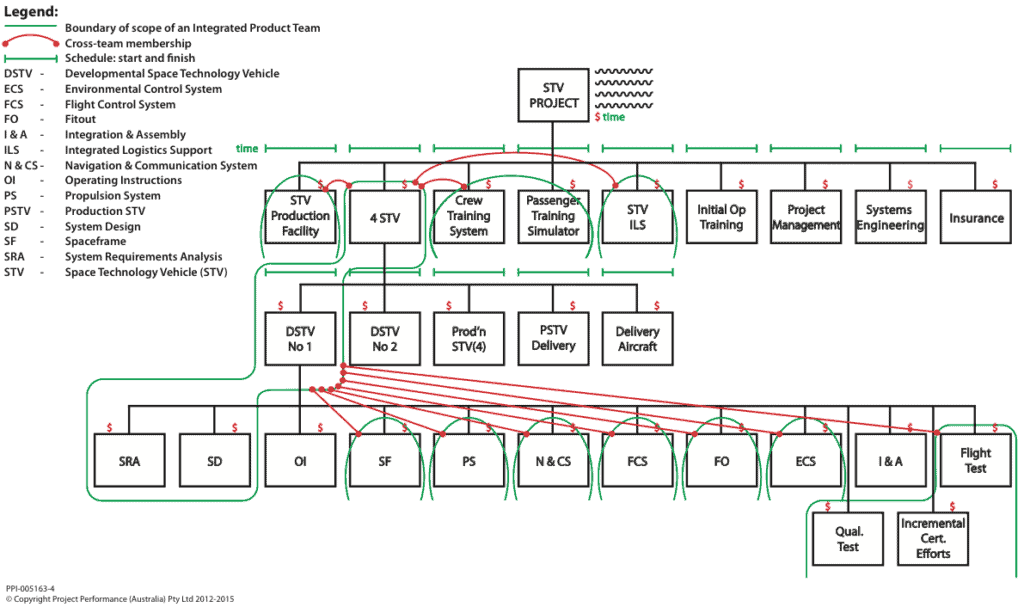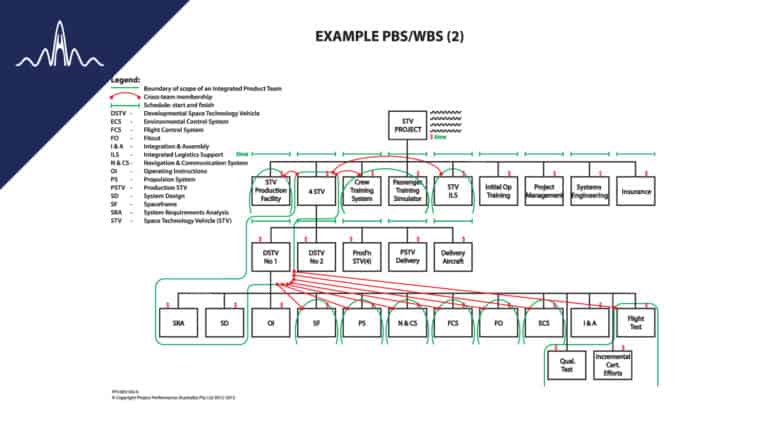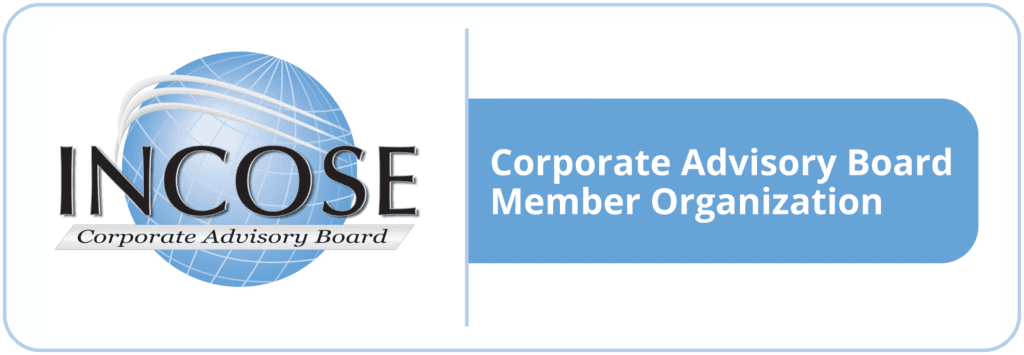1. INTRODUCTION TO WBS/PBS
1.1 What a WBS Is and Isn’t
Let’s get one thing straight. A “Work” Breakdown Structure (WBS) isn’t a breakdown of work. WBS is a really, really bad name. A “Work” Breakdown Structure is actually a product-oriented breakdown of a project into products and services organized in a way that shows how the deliverables of the project are to be created (product) or performed (services) and other project outcomes are achieved.
From here on we are going to call it a Project Breakdown Structure (PBS) – not to be confused with a Product Breakdown Structure.
- What Does a PBS Look Like?
Let’s see:

Figure 1.2-1 PBS for a Space Tourism Business System
1.3 Concept and Use of the PBS
The PBS as framework for planning and control of a project has been well known since the PBS was invented by the United States Navy in the 1950s. The PBS is a hierarchical breakdown that is strongly oriented towards the structure of the end products to be supplied by the project. Under product orientation, the products and the services needed to bring into existence end and intermediate products are subordinate elements of those products within the PBS. For services, the services and the products needed to perform the services are subordinate elements of those services within the PBS
The product orientation of the PBS facilitates its use as a project-wide framework for:
- definition of deliverable products and services;
- definition of products and services internal to the project;
- costing and cost management;
- scheduling and schedule management;
- risk analysis;
- assignment of responsibility;
- measurement;
- reporting;
- organisational design;
- work assignment;
- work authorization;
- identification of stakeholders in subordinate (non-deliverable) elements; and
- contracting and sub-contracting.
The PBS is a hugely powerful tool in planning, assessing the performance of and controlling a project. The PBS is integral to the implementation of Earned Value Methodology (EVM)-based cost/schedule control systems, technical performance measurement (TPM) systems and integrated project performance measurement.
We now turn to examine product orientation in more detail.
2. PRODUCT ORIENTATION
To be product oriented, each element of the PBS should, as a guiding principle, include all lower level products, materials and services required to realise that product or service.
Consider Figure 1.2-1, which shows a product-oriented PBS:
- each set of adjacent elements in a branch of the product oriented PBS defines the set of contained elements (products and services) that have to be brought together at that level to realise the containing element.
- each set of adjacent elements in a branch of the product oriented WBS is a logical grouping for schedule planning purposes, since the individual starts and completions of these elements define the start and completion of the containing element.
- the requirements of the containing element drive the requirements of each contained element. The product oriented WBS fosters a requirements orientation towards the end result.
- the product oriented WBS provides a natural framework around which to design a technical review program; and
- the product oriented WBS establishes a framework for definition of supplier/customer relationships within the project, including internal supplier/customer relationships.
Although product orientation is very important, departures are appropriate in some circumstances, for example:
- where strict adherence to pure product organisation would produce PBS elements which are too small to be cost-effective;
- where work is of a highly interactive nature spanning multiple levels of a product-oriented PBS, for example, project management;
- where the project is long and phased in nature, with each phase having defined deliverables, in which case an orientation at level 2 towards phases, which tend to be functional in character, may be preferable; and
- where projects involve tasks performed repetitively, and very little integration is required between the outputs of those tasks to form the end product, for example, detailing a fleet of 500 cars.
3. BUILDING A GREAT PBS
3.1 For a Project With Two Or More Products and/or Services as Deliverables
The level 1 element is the project.
To define level 2 elements:
- What products (physical/software/data) are required to be delivered by the project?
- What services are required to be delivered by the project?
- What services are necessary, internal to the project, to deliver the project outputs and outcomes, that are not needed uniquely to create (for physical/software/data product) or deliver (for a service) just a single element from questions 1 and 2?
One answer to this last question is always “Project Management”
- What products, if any, internal to the project, that involve project cost or other resources in their realization, are necessary to deliver the project outputs and outcomes, that are not needed uniquely to create (for a physical/software/data product) or deliver (for a service) just a single element from questions 1, 2 and 3?
To define sub-elements below level 2, the questions for a product element are:
5-1. What products are to be integrated to create this product element?
5-2. In addition to the products from question 5-1, what services are to be performed to create this product element, that are not needed uniquely to create just a single sub-element from question 5-1?
5-3. In addition to the products and services from questions 5-1 and 5-2 respectively, what products are necessary, that involve project cost or other resources in their realization, to create this product element, that are not needed uniquely to create (for
physical/software/data product) or perform (for a service) just a single sub-element from questions 5-1 and 5-2 respectively?
To define sub-elements below level 2, the questions for a service element are:
6-1. What services are to be integrated to perform this service element?
6-2. In addition to the services from question 6-1, what products are necessary to perform this service element, that involve project cost or other resources in their realization, and that are not needed uniquely to perform just a single service sub-element from question 6-1.
3.2 For a Project With Just One Product as the Deliverable
Example project: the bicycle project in the PMI Practice Standard for Work Breakdown Structures Second Edition, or an enterprise-level system.
The level 1 element is the project.
To define level 2 elements:
- What products are to be integrated to create this sole deliverable product?
- In addition to the products from question 1, what services are to be performed to create the sole deliverable product, that are not needed uniquely to create just a single element from question 1?
- In addition to the products and services from questions 1 and 2 respectively, what products are necessary, that involve project cost or other resources in their realization, to create the sole deliverable product, that are not needed uniquely to create (for physical/software/data product) or perform (for a service) just a single element from questions 1 and 2 respectively?
To define sub-elements below level 2, the questions for a product element are:
4-1. What products are to be integrated to create this product element?
4-2. In addition to the products from question 4-1, what services are to be performed to create this product element, that are not needed uniquely to create just a single sub-element from question 4-1?
4-3. In addition to the products and services from questions 4-1 and 4-2 respectively, what products are necessary, that involve project cost or other resources in their realization, to create this product element, that are not needed uniquely to create (for
physical/software/data product) or perform (for a service) just a single sub-element from questions 4-1 and 4-2 respectively?
To define sub-elements below level 2, the questions for a service element are:
5-1. What services are to be integrated to perform this service element?
5-2. In addition to the services from question 5-1, what products are necessary to perform this service element, that involve project cost or other resources in their realization, and that are not needed uniquely to perform just a single service sub-element from question 5-1?
3.3 For a Project With Just One Service as the Deliverable
The level 1 element is the project.
To define level 2 elements:
- What services are to be integrated to deliver this sole deliverable service?
- In addition to the services from question 1, what products are necessary, that involve project cost or other resources in their realization, to perform this sole deliverable service, that are not needed uniquely to perform just a single service element from question 1?
To define sub-elements below level 2, the questions for a product element are:
3-1. What products are to be integrated to create this product element?
3-2. In addition to the products from question 3-1, what services are to be performed to create this product element, that are not needed uniquely to create just a single sub-element from question 3-1?
3-3. In addition to the products and services from questions 3-1 and 3-2 respectively, what products are necessary, that involve project cost or other resources in their realization, to create this product element, that are not needed uniquely to create (for physical/software/data product) or perform (for a service) just a single sub-element from questions 3-1 and 3-2 respectively?
To define sub-elements below level 2, the questions for a service element are:
4-1. What services are to be integrated to perform this service element?
4-2. In addition to the services from question 4-1, what products are necessary to perform this service element, that involve project cost or other resources in their realization, and that are not needed uniquely to perform just a single service sub-element from question 4-1?
4. PARTS OF A PBS
The PBS comprises:
- a PBS index, which is a family tree graphic or indented list organised by name of the elements of the product breakdown; and
- a PBS dictionary, which describes at a level suitable for management purposes the scope of each PBS element, such that the aggregation of scopes under each entry in the PBS dictionary encapsulates all products to be produced and all work to be performed in their realisation. The PBS dictionary does not specify in full the products or the work tasks – it is only as detailed as is necessary to allow the unambiguous association of every hour of labour and every dollar of expenditure to a corresponding PBS element.
Figure 4-1 shows an example entry in a WBS dictionary.
5. TIMING OF DEVELOPMENT
A project that involves little innovation may be amenable to development of the complete and final PBS as a part of initial project planning. Conversely, a project containing many unknowns will necessarily have the PBS evolve over the planning and design phase(s) of the project to its full level of detail. The PBS should be formally adopted only to the level at which it is relatively mature. This level may not be uniform across the PBS.
Since the PBS serves as the framework for project cost and schedule estimation and planning, a popular technique is to differentiate on the PBS between those elements which have been approved for project control and those that exist with provisional status for planning purposes.
6. CORRESPONDENCE WITH DEVELOPMENT
The PBS and the technical program should at all times be in correspondence. If this correspondence is not maintained:
- control over cost, schedule and quality will be weakened or lost;
- additional stages of, and specifications for, system integration may be needed; and
- the technical program may not produce deliverables that correspond to milestone events, or payment or sell-off criteria contracts are involved.
The PBS should reflect the determinations of the technical program, and not the reverse – many a project has failed because of an unsuitable, sometimes arbitrary PBS structure, or a template structure mandated by a customer or by company management.

Figure 4-1 Example PBS Dictionary Page
7. CORRESPONDENCE WITH PROJECT/CONTRACT DELIVERABLES
The PBS, in its product orientation, should align closely with the deliverables defined for the project, and then extend those deliverables downwards in the structure.












